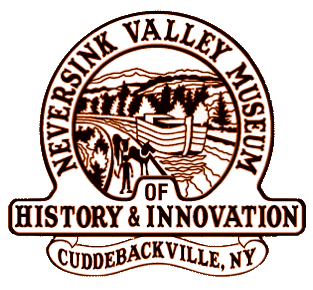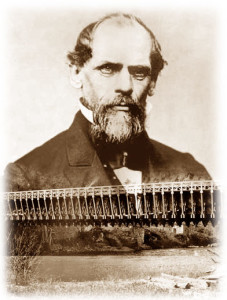John A. Roebling: Engineer-Philosopher
The great fun of historic research is in the many forks in the twisting trails one finds oneself following. As a historian works to put dates and facts into a context that not only explains the story of those facts, but also relates them to other, seemingly unrelated, historical events, he can find himself on some truly unexpected paths.
Things in Prussia were oppressive for the people: there was a depression, the government was autocratic and society was incredibly structured. After the 1830 French Revolution, there was general unrest throughout Western Europe: France now had a constitutional monarchy. Although the rulers in Prussia were able to have their way, the success of the French people spurred the Liberal and Democrat political parties in Prussia to be much more vocal. This was just the situation to convince an idealist young architecture and engineering student to leave his home in Muhlhausen and immigrate to the United States.
Not just an engineer and mathematician, Johann A. Röbling was a student of the great German philosopher Georg Wilhelm Friedrich Hegel. Hegel taught that reality was rational and that freedom was part of the natural order of things. Hegel also believed that the world worked in a dialectical manner where every situation gives rise to its opposite and that the consequence is a synthesis of both resulting in a state of affairs better than its predecessors. This made history a rational, progressive process. The Hegelian dialectical theory resulted in an optimistic worldview where the notion of progress is built into the very nature of creation. Hegel’s view of the United States in the early 19th century was clear: “It is a land of hope for all who are wearied of the historic armory of old Europe,” Hegel taught. “There the future would be built. There in all that “immeasurable space” a man might determine his own destiny.”
The Hegelians believed that Ethics was based on universal validity, not individual whim. As a Hegelian, Roebling believed in progress as part of the natural order of things and had a life-long quest for the betterment of mankind. He was also a strong believer in the evil of slavery and wrote: A Few Considerations for the President of the United States (a discussion on the nature of evil – especially slavery — directed to A. Lincoln). Even though he devoted time to designing bridges over the Allegheny and Monongahela Rivers, the Niagara Gorge, the Ohio River, and for our own D & H Canal, Roebling never gave up his interest in philosophy.
In 1831, after publishing a pamphlet to encourage others to leave Muhlhausen with them, John, his brother Karl, Johann Etzler (another engineer) and about 14 others set sail for the United States to form a utopian community. Upon their arrival in Philadelphia, they first thought about going south, but the existing slave system made them change their minds. The next goal was to go to the western frontier, but they stopped in Butler County, Pennsylvania, outside of Pittsburgh, due to financial constraints.
They first named their community Germania, later Saxonburg, and Johann Röbling changed his name to John Roebling. Had the soil been better for farming, John might not have looked for engineering work. The Allegheny Portage railroad used hemp to move the train cars. Roebling had read an obscure German engineering paper about fabricating rope from wire in 1840. He began experimenting and soon proposed using the much stronger wire rope instead of hemp. His method of manufacture earned Roebling the first of his many patents.
Roebling’s mathematics notebooks are filled with nearly countless equations written carefully in a small, precise hand. His drawings for projects from the earliest days until his plans for the Brooklyn Bridge are also meticulous, intensely detailed and beautiful works of art in their own right.
Roebling had studied Claude-Louis Navier’s theory on suspension bridges, and was tutored on this subject by the celebrated professors J.F. Dietleyn and J.A. Eytelwein while he was studying in Berlin. He also studied the few suspensionbridges built in Prussia, and knew he could do better, though he could not get any contracts. Once he had perfected his wire rope in Pennsylvania, he knew it would be much stronger than the chains that were being used for bridge construction and began looking for commissions. His first major project was the Allegheny Aqueduct Bridge in Pittsburgh in 1844
While working on the 1595 foot Brooklyn Bridge, Roebling’s foot was crushed by a ferry. Because his beliefs would only allow hydrotherapy – the pouring of water over the wound, it became infected and he died of tetanus in his son’s apartment overlooking the site of the bridge that was to be his greatest legacy.
A 19th Century DaVinci, Roebling left behind plans for a steam-powered airship and armored vehicles. His work lives on through the iconic Brooklyn Bridge and through the work of his sons who followed in his footsteps. John Roebling’s Sons Wire Rope Company supplied the wire rope for the Golden Gate and George Washington Bridges, to the elevator industry, and for the North Sea mine fields that stopped the German submersibles in World War I. Nearly a century after John’s death, his grandson, Donald Roebling, a noted philanthropist, invented he Amphibious Landing Vehicle used in World War II. After the Brooklyn Bridge was completed, as the John A. Roebling’s Sons company grew, John’s son Charles designed and built a new factory and company town 10 miles south of Trenton, now Roebling, New Jersey.
For a look at this town and its steel mill, the Images of America series title, “Roebling,” is available at our museum gift shop.
Information gathered at the Roebling Family Collection, Special Collections and University Archives, Rutgers University Libraries was invaluable in preparing this article.
Copyright 2007 by Seth Goldman
Short Link:

